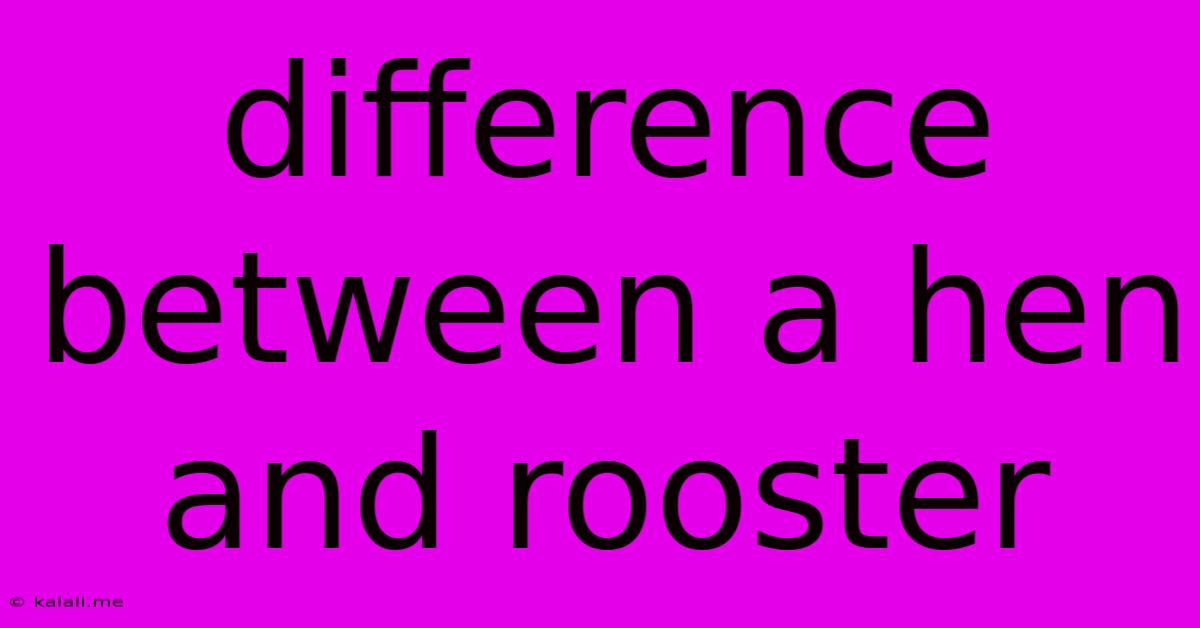Difference Between A Hen And Rooster
Kalali
May 31, 2025 · 3 min read

Table of Contents
The Hen vs. Rooster: Unraveling the Differences Between These Backyard Birds
This article delves into the key distinctions between hens and roosters, covering everything from their physical characteristics and behaviors to their roles in the flock and economic value. Understanding these differences is crucial for anyone considering raising chickens, whether for eggs, meat, or simply as pets. This guide will equip you with the knowledge to easily identify a hen from a rooster, regardless of breed.
Physical Differences: Spotting a Hen from a Rooster
The most noticeable differences between hens and roosters lie in their physical attributes. While breed variations exist, some consistent characteristics help distinguish them:
Size and Weight: Roosters are generally larger and heavier than hens of the same breed. This difference becomes more pronounced as they mature.
Comb and Wattles: Both hens and roosters possess combs and wattles (fleshy, red appendages on their heads and necks), but a rooster's are usually significantly larger, brighter red, and more erect. A hen's comb and wattles are typically smaller and less vibrant.
Plumage: While plumage varies widely depending on the breed, roosters often exhibit more vibrant and elaborate plumage than hens. They may have longer tail feathers, saddle feathers (feathers on the back just above the tail), and hackle feathers (long, flowing feathers on the neck).
Tail Feathers: Roosters boast longer and more prominent tail feathers, often forming a distinctive upward sweep. Hen's tail feathers are shorter and less noticeable.
Spurs: Roosters typically have spurs – sharp, bony projections on their legs – that they use for fighting and establishing dominance within the flock. Hens may have small, barely visible spurs, or none at all.
Behavior: Beyond physical attributes, behavioral differences are equally important in identifying hens and roosters.
Behavioral Differences: Observing Their Actions
Observing the behavior of chickens is just as important as examining their physical characteristics. Here are some key differences in their behaviors:
Vocalizations: Roosters are renowned for their crowing, a loud and distinctive call that announces their presence and dominance. Hens make various clucking and cackling sounds, but they don't crow. The crowing of a rooster is a defining characteristic.
Aggression: Roosters are generally more aggressive than hens, particularly towards other roosters. They frequently fight to establish dominance within the flock. Hens, while sometimes displaying aggression toward each other, are less likely to engage in aggressive physical confrontations.
Mating Behavior: The rooster's role is to mate with the hens. They will actively pursue hens, displaying courtship behaviors. The hen's role is to lay eggs and brood chicks.
Broodiness: Hens exhibit broodiness – a strong nesting instinct where they sit on their eggs to incubate them. Roosters do not exhibit broodiness.
Roles in the Flock and Economic Value: Beyond the Basics
Understanding the different roles hens and roosters play within a flock clarifies their overall economic value.
Egg Production: Hens are the primary egg layers. The number of eggs laid depends on breed, age, and environmental factors. Roosters do not lay eggs.
Meat Production: Both roosters and hens can be raised for meat, although roosters are often preferred due to their larger size. However, many backyard chicken keepers choose to keep only hens to focus solely on egg production.
Fertility: Roosters are essential for fertile eggs, which are needed for hatching chicks. Hens alone cannot produce fertile eggs.
Conclusion: Identifying Hens and Roosters with Confidence
By carefully observing both physical characteristics and behavioral patterns, you can confidently distinguish between a hen and a rooster. Understanding these distinctions is vital for successful chicken keeping, allowing you to manage your flock effectively and maximize your poultry goals, whether it's egg production, meat production, or simply enjoying the company of these fascinating birds.
Latest Posts
Latest Posts
-
Bathroom Sink Drains Slowly Not Getting Air
Jun 01, 2025
-
Kitchen Faucet Hot Water Not Working
Jun 01, 2025
-
Color Palette Tiefling Skin Color Chart
Jun 01, 2025
-
Word To Describe Someone When They Know What They Want
Jun 01, 2025
-
Who Said A Chicken In Every Pot
Jun 01, 2025
Related Post
Thank you for visiting our website which covers about Difference Between A Hen And Rooster . We hope the information provided has been useful to you. Feel free to contact us if you have any questions or need further assistance. See you next time and don't miss to bookmark.